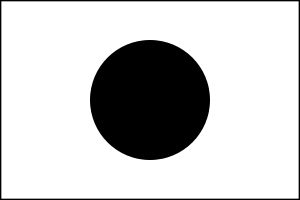Translation:Law Regarding the National Flag and National Anthem
Law Regarding the National Flag and National Anthem (Law No. 127 of August 13, 1999)
(Flag)
Article 1: The Nisshōki shall be the National Flag.
Section 2: The construction details of the Nisshōki shall be published in Appendix 1 of this Law.
(Anthem)
Article 2: Kimigayo shall be the National Anthem.
Section 2: The lyrics and musical notation of Kimigayo shall be published in Appendix 2 of this Law.
(Supplementary Provisions)
(Effective Date)
Article 1: This Law will come into force upon its promulgation.
(Repeal of Previous Ordinance)
Article 2: The Ordinance "Proclamation No. 57 on February 27, 1870" shall be repealed.
(Exceptions to the Law)
Article 3: For flags manufactured before the passage of this Law, notwithstanding the provisions in this Law, the flag's ratio may be seven units length by ten units width (7:10 ratio) and the sun is placed in the center of the flag and shifted 1/100ths toward the hoist.
Appendix 1
(Related to Article 1)
Design of the Nisshōki:

Section 1: Ratio of the Flag and the Nisshō Symbol
- Flag ratio: Two units length and three units width (2:3)
- Nisshō size: 3/5ths of the flag's total length
- Position of the Nisshō on the flag: Direct center
Section 2: Colors
- Background: White
- Nisshō: Dark red
Appendix 2
(Related to Article 2)
The lyrics and musical notation for Kimigayo:
Section 1 - Lyrics
- 君が代は 千代に八千代に さざれ石の いわおとなりて こけのむすまで (Kimi ga Yo wa, Chiyo ni Yachiyo ni, Sazare-ishi no, Iwao to narite, Koke no musu made.)
![]()
![]() This work is a translation and has a separate copyright status to the applicable copyright protections of the original content.
This work is a translation and has a separate copyright status to the applicable copyright protections of the original content.
| Original: |
This work is in the public domain in the U.S. because it is an edict of a government, local or foreign. See § 313.6(C)(2) of the Compendium II: Copyright Office Practices. Such documents include "legislative enactments, judicial decisions, administrative rulings, public ordinances, or similar types of official legal materials" as well as "any translation prepared by a government employee acting within the course of his or her official duties." These do not include works of the Organization of American States, United Nations, or any of the UN specialized agencies. See Compendium III § 313.6(C)(2) and 17 U.S.C. 104(b)(5). A non-American governmental edict may still be copyrighted outside the U.S. Similar to {{PD-in-USGov}}, the above U.S. Copyright Office Practice does not prevent U.S. states or localities from holding copyright abroad, depending on foreign copyright laws and regulations.
Public domainPublic domainfalsefalse
This work is in the public domain because, according to Article 13 of the Copyright Act of Japan, this work is not eligible for copyright. The provisions of Article 13 shall not grant copyright to a work falling under any of the following categories:
Public domainPublic domainfalsefalse |
|---|---|
| Translation: |
I, the copyright holder of this work, hereby release it into the public domain. This applies worldwide. In case this is not legally possible: I grant anyone the right to use this work for any purpose, without any conditions, unless such conditions are required by law.
Public domainPublic domainfalsefalse |
